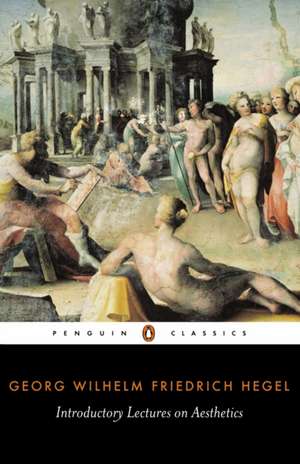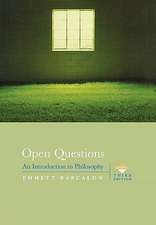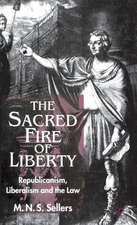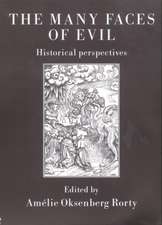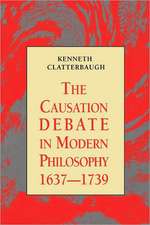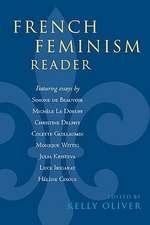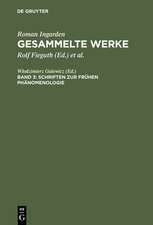Introductory Lectures on Aesthetics
Autor Georg Hegel Editat de Michael Inwood Traducere de Bernard Bosanqueten Limba Engleză Paperback – 26 mai 1993
Preț: 57.61 lei
Preț vechi: 69.28 lei
-17% Nou
11.02€ • 11.51$ • 9.12£
Carte disponibilă
Livrare economică 20-26 martie
Specificații
ISBN-10: 014043335X
Pagini: 256
Dimensiuni: 129 x 198 x 15 mm
Greutate: 0.19 kg
Editura: Penguin Books
Colecția Penguin Classics
Locul publicării:London, United Kingdom
Notă biografică
Hegel (1770-1831) is one of hte most important of modern philosophers, due to his relation to Marx and the support his philosophy seemed to offer to theories of nationalism and social democracy, and his impact on a range of humanities. He is best known for The Phenomenology of Spirit, The Science of Logic, The Encyclopedia of the Philosophical Sciences, and The Philosophy of Right, as well as his lectures, which were published posthumously by his friends.
Bernard Bosanquet was a Fellow of University College, Oxford teaching philosophy and ancient history. From 1903 to 1908 he held the chair of moral philosophy at St Andrews. He died in 1923.
Descriere
No philosopher has held a higher opinion of art than Hegel, yet nor was any so profoundly pessimistic about its prospects - despite living in the German golden age of Goethe, Mozart and Schiller. For if the artists of classical Greece could find the perfect fusion of content and form, modernity faced complicating - and ultimately disabling - questions. Christianity, with its code of unworldliness, had compromised the immediacy of man's relationship with reality, and ironic detachment had alienated him from his deepest feelings. Hegel's Introductory Lectures on Aesthetics were delivered in Berlin in the 1820s and stand today as a passionately argued work that challenged the ability of art to respond to the modern world.
Cuprins
Chapter I: The Range of Aesthetic Defined, and Some Objections against the Philosophy of Art Refuted [α Aesthetic confined to Beauty of Art β Does Art merit Scientific Treatment? γ Is Scientific Treatment appropriate to Art? δ Answer to β ε Answer to γ]
Chapter II: Methods of Science Applicable to Beauty and Art [1. Empirical Method - Art-scholarship (a) Its Range (b) It generates Rules and Theories (c) The Rights of Genius 2. Abstract Reflection 3. The Philosophical Conception of Artistic Beauty, general notion of]
Chapter III: The Conception of Artistic Beauty Part I - The Work of Art as Made and as Sensuous 1. Work of Art as Product of Human Activity [(a) Conscious Production by Rule (b) Artistic Inspiration (c) Dignity of Production by Man (d) Man's Need to produce Works of Art] 2. Work of Art as addressed to Man's Sense [(a) Object of Art - Pleasant Feeling? (b) Feeling of Beauty - Taste (c) Art-scholarship (d) Profounder Consequences of Sensuous Nature of Art (α) Relations of the Sensuous to the Mind (αα) Desire (ββ) Theory (γγ) Sensuous as Symbol of Spiritual (β) The Sensuous Element, how Present in the Artist (γ) The Content of Art Sensuous]
Part II - The End of Art 3. [The Interest or End of Art (a) Imitation of Nature? (α) Mere Repetition of Nature is - (αα) Superfluous (ββ) Imperfect (γγ) Amusing Merely as Sleight of Hand (β) What is Good to Imitate? (γ) Some Arts cannot be called Imitative (b) Humani nihil - ? (c) Mitigation of the Passions? (α) How Art mitigates the Passions (β) How Art purifies the Passions (αα) It must have a Worthy Content (ββ) But ought not to be Didactic (γγ) Nor explicitly addressed to a Moral Purpose (d) Art has its own Purpose as Revelation of Truth]
Chapter IV: Historical Deducation of the True Idea of Art in Modern Philosophy 1. Kant [(a) Pleasure in Beauty not Appetitive (b) Pleasure in Beauty Universal (c) The Beautiful in its Teleological Aspect (d) Delight in the Beautiful necessary though felt] 2. Schiller, Winckelmann, Schelling 3. The Irony
Chapter V: Division of the Subject [1. The Condition of Artistic Presentation is the Correspondence of Matter and Plastic Form 2. Part I - The Ideal 3. Part II - The Types of Art (α) Symbolic Art (β) Classical Art (γ) Romantic Art 4. Part III - The Several Arts (α) Architecture (β) Sculpture (γ) Romantic Art, comprising (i) Painting (ii) Music (iii) Poetry 5. Conclusion]
Commentary
